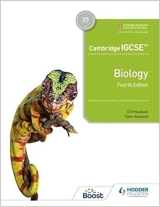Chapter 14. Excretion and the kidneys
Page 131
1. Carbon dioxide, urea, uric acid, water, salts, spent hormones, toxins, bile pigments.
2. Levels of urea, uric acid and breakdown products of hormones will give a clue as to how well
the kidneys are working. Urine analysis will reveal substances that should not be there such as
glucose, proteins, blood cells or drugs. These substances may lead to a diagnosis of a
disease. (This information is not given in the text).
Page 134
1. It is the pressure of the blood which forces blood plasma (minus proteins) out of the
capillaries of the glomerulus and into the renal capsule. With a fall in blood pressure, less
fluid reaches the renal capsule. As a result, nitrogenous waste and other harmful substances
remain circulating in the blood.
2. The renal vein will contain less urea, uric acid, salts, water and harmful substances than the
renal artery. It will also contain less oxygen and more carbon dioxide.
3. Filtration; glomerulus. Reabsorption; renal tubule. Storage of urine; bladder. Transport of
urine; ureter. Osmoregulation; collecting duct*.
(*Not mentioned in text. ‘Renal tubule’ would be acceptable).
4. Loss of water during sweating causes an increase in the concentration of the blood so less
water is reabsorbed by the kidney. This leads to a reduction in the volume of urine produced.
This smaller volume still has to contain all the excretory products and so it becomes darker.
When sweating ceases, there is more excess water to be removed by the kidneys, so urine
production increases and dilutes the excretory products with the result that the urine is almost
colourless.
5. The molecule of urea leaves the liver in the hepatic vein which joins the vena cava. The vena
cava delivers its blood to the right atrium of the heart. The urea molecule then passes from
the right atrium to the right ventricle and enters the pulmonary artery and, after passing
through the lungs, enters the pulmonary vein which opens into the left atrium. It is pumped
out by the left ventricle into the aorta which gives off a branch, the renal artery, which
delivers the urea molecule to the kidneys. The molecule is filtered out of a glomerulus into a
renal capsule which passes the urea molecule down the renal tubule to the pelvis of the
kidney. From here the molecule passes down a ureter to the bladder, and to the outside world
in the urine.
6. This question is flawed. The result does not give an answer compatible with the known
figures. Apologies.
Page 136
1. a The kidneys. b The liver. c The skin. d The lungs.
2. a The dialysis machine resembles the kidney in that it filters unwanted substances through a
membrane.
b It differs from the kidney in the way that it prevents the loss of useful substances. In the
kidney these are reabsorbed into the blood as they pass down the renal tubule. In the dialysis
machine they are prevented from escaping by maintaining a solution outside the tube which
carries the same concentration of these substances as in the blood, so that there is no diffusion
gradient. |
Downloads
Download the answers in PDF format below
Section 1, Chapters 1-5
Section 2, Chapters 6-9
Section 3, Chapters 10-12
Section 3, Chapters 13-17
Section 3, Chapters 18-20
Section 4, Chapters 21-24
Section 5, Chapters 25-27
Section 5, Chapters 28-29
Section 6, Chapters 30-34
Section 6, Chapters 35-37
Section 7, Chapters 38-39
Section 8, Chapters 40-41
|
